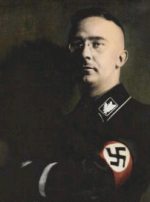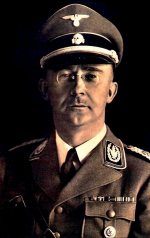Heinrich Himmler was born in
München (Munich) on
7 October 1900, as second son of the pious authoritarian Roman
Catholic schoolmaster Gebhard Himmler. Educated at secondary school in
Landshut,
Himmler served as an officer cadet in the 11th Bavarian Regiment at the end of WW1, although he saw no
active service.
After working briefly as a salesman for a fertilizer manufacturing firm, Himmler joined the
Nazi party and in
November 1923 participated in the Beer-Hall
Putsch as a standard
bearer at the side of
Ernst Röhm. On the re-formation
of the party, his diligence and loyalty were rewarded when he was appointed head of
Hitler’s personal bodyguard in
January 1929.
The black-shirted
Schutzstaffel, better known as the SS, was at that time a small body of 200 men.
Under his leadership this small force grew to become an all-embracing empire within the Nazi "Third Reich"
(
SS ranks).
 |
| Gudrun Himmler |
Himmler supplemented his modest salary by running a small holding near
München with his wife
Marga,
whom he had married in
1927, and who shared both his interest in country life and his
fetish for herbal medicines.
Marga bore him a daughter,
Gudrun, in
1929.
Himmler was essentially a desk worker with a pedantic head for detail. He compensated
for his own physical deficiencies through his obsession with racial purity and the athletic
prowess of his men. As early as
1931 he instituted a marriage code for the SS that forbade
any man to take a bride who could not prove the purity of her Aryan blood for a couple of centuries.
He created SS bride schools and also established
Lebensborn maternity
institutions, where young girls selected for their pure Nordic traits could procreate with SS-men.
Their offspring were better cared for than in normal maternity homes.
Himmler’s acquisition of power was achieved by subtle and devious means. After being
appointed Commander of the political police throughout Bavaria, he was appointed head
of the Prussian Police and
Gestapo on
20 April 1934.
The turning-point in Himmler’s career was his masterminding of the purge of the SA,
on
29/30 June 1934, which eliminated the power of the SA and paved the way for the
emergence of the SS as an independent, all powerful organisation. He was ably supported by
Reinhard Heydrich who headed the intelligence
service of the party, the
Sicherheitsdienst, better known as the SD.
Heydrich had the stomach for the more ruthless aspects of Nazi racial
policy that left Himmler feeling uncomfortable.
In
1933 Himmler set up the first concentration camp in
Dachau,
and in the next few years, with
Hitler’s encouragement, greatly
extended the range of persons qualified for internment in the camps. In
October 1939
Hitler appointed him
Reichskommissar für die Festigung
des Deutschen Volkstums and Himmler was given absolute control over the newly
annexed Polish territories. Responsible for bringing people of German descent back from
outside the
Reich to within its newly expanded borders, Himmler set out to replace
Poles and Jews by
Volksdeutsche from the Baltic lands, various outlying parts of
Poland, and elsewhere. Within a year over a million Poles and 300,000 Jews had been
uprooted and driven eastwards. In carrying out his task as supreme overseer of the Final
Solution, Himmler proved himself a fanatical disciple of Nazi racial theory with an unswerving
dedication to its translation into stark reality.
By the time of the invasion of the Soviet Union in
June 1941, Himmler’s
complete strangle-hold of the police and security services was evident. He controlled the
Reich Main Security
Office (RSHA), firstly via
Heydrich and then subsequently
Kaltenbrunner, the criminal police under
Nebe,
the Foreign Political Intelligence service under
Schellenberg,
and the
Gestapo under
Müller. Through the SS he ruled supreme
over the concentration camps and the death camps in Poland,
Belzec,
Sobibor and
Treblinka. Himmler instructed
Odilo Globocnik, the
SSPF Lublin,
to construct these extermination camps in order to effect the destruction of the European Jewry (see the page
on his visits to these
Aktion Reinhard camps).
Himmler also created the
Waffen-SS, a powerful private army, whose strength he had expanded from three to
thirty five divisions, making it a rival military force to the
Wehrmacht. In
August 1943 Himmler was appointed Minister of the Interior, giving him jurisdiction
over the courts and the Civil Service.
 |
| In the East |
Himmler gave a notorious
speech on
4 October 1943 to the SS Group Leaders in
Poznan ("
Posener Rede"), where he spoke
about the extermination of the Jewish people in glowing terms, saying “This is a page of
glory in our history which has never been written and shall never be written.” Following the
plot against
Hitler in
July 1944,
Himmler’s position was strengthened still further and the
Wehrmacht was forced to accept him as Commander
in Chief of the Reserve Army in addition to all his other activities. Himmler was granted supreme command of the
Army Group Vistula, despite his lack of military experience.
Realising the war was lost, Himmler attempted to approach the Allies for peace negotiations through the Head of the
Swedish Red Cross, Count
Folke Bernadotte. Himmler ordered the cessation of the mass
slaughter of the Jews, and proposed the surrender of the German armies in the west, including Denmark and Norway, but
the fight against the Russians would continue.
Hitler, learning of the betrayal
of his most trusted and loyal disciple was enraged, stripping Himmler of all of his offices.
Following the German surrender Himmler took on a false identity and tried to escape, but was captured with a number
of other SS men in (or near)
Bremervörde (Lower Saxony). Himmler committed
suicide on
23 May 1945.
His body was buried in an unmarked grave near
Lüneburg (See:
Himmler's Last Days).
See our
Himmler Photo Story!
Sources:
Arad, Yitzhak.
Belzec, Sobibor, Treblinka - The Operation Reinhard Death Camps, Indiana University Press,
Bloomington and Indianapolis, 1987
Robert S Wistrich.
Who’s Who in Nazi Germany. Routledge London 1995
Gerald Reitlinger.
The Final Solution, Valentine and Mitchell 1953
© ARC 2005











